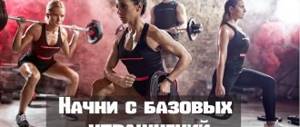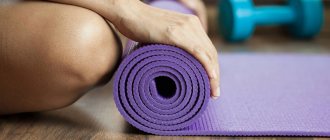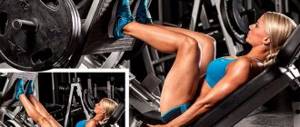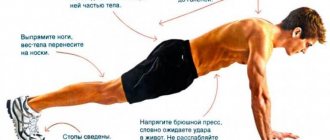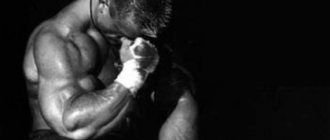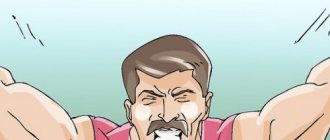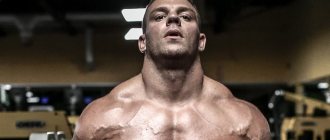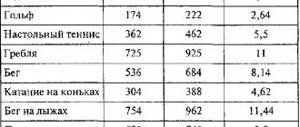≡ February 2, 2021 Category: Articles
Bodybuilding or bodybuilding is not just strength training. This is a lifestyle that requires constant training and willpower. First of all, a novice bodybuilder must have all the necessary knowledge to create his own training program, which will later help him adapt to training in the gym. At this stage, the foundation of physical fitness is laid. But there is no need to rush and load yourself with a dozen exercises at the same time. It is very important to remember that bodybuilding cannot be rushed. The basis of this sport is a system of loads and a recovery system.
Nutrition rules
Basic nutrition rules:
- You should drink plenty of water throughout the day;
- Never mix carbohydrates;
- Always weigh your food;
- You can eat 2-3 hours before training, but you can snack on an apple half an hour before training;
- Eliminate sparkling water, factory-made juices, and other foods that contain “empty” calories from your diet;
- Salads are best seasoned with olive oil;
- Do not eat foods high in carbohydrates and fats.
Below are products that must be present in the diet of any bodybuilder.
Protein sources
High protein foods:
- Chicken fillet or veal;
- Chicken eggs and cottage cheese;
- Legumes;
- Seafood.
These foods help build muscle mass as they contain large amounts of protein.
Sources of carbohydrates
Carbohydrates can be obtained from foods such as:
- Cereals, in particular buckwheat porridge;
- Durum pasta;
- Apples;
- Greenery;
- Tomatoes and cucumbers.
"Harmful" products
The following foods should be completely removed from your diet:
- Soda;
- Smoked products;
- Pickles;
- Confectionery;
- Semi-finished products;
- Buns and pies.
It is very important for a beginner athlete to adhere to the right diet if he wants to gain muscle mass. Also, all bodybuilders know that they should consume protein and carbohydrates within 20-40 minutes after training, as this is when they will bring the most benefits.
As for bad habits, you need to completely give up smoking, alcohol and lack of sleep. Sleep should be healthy and last at least 8 hours. It is very important to accustom your body to a systematic daily routine. This is necessary in order to feel as alert as possible during training.
You should come to class only when you have reached full super compensation, that is, you are well rested. The duration of this period is not that long, so you shouldn’t rest for too long either. But it’s still better to rest and recuperate a little longer than to come to training feeling unwell, as this is a direct path to overtraining. Overtraining leads to many health problems.
Training time
Many argue that it is better to train exclusively in the morning, because then our body produces substances that contribute to faster results in bodybuilding. In addition, a person’s energy level is much higher in the morning than in the evening. But many athletes, professional ones at that, train during the day and in the evenings.
Some even at night. For example, the famous Boyer Coe trained for several years from 2 to 4 am, every day. He had no time to study anymore, because he was studying and working. If you think about it, in essence this athlete did not follow the sleep and rest schedule and overexerted himself, which is also important.
But nevertheless, his desire for high results in bodybuilding allowed him to become one of the champions, despite the fact that his life schedule was not exactly the one that athletes are advised to follow. What does this mean?
It doesn't really matter when you train - the main thing is that you train regularly. Of course, the best option, especially for beginners, is to train when your energy level is at its highest. But the most important factor for success is consistency.
What is load progression?
It should be noted that the progressiveness of the load can be different: this is an increase in the intensity of training, and a decrease in the speed with which this or that exercise is performed. However, it is best for beginners to improve their performance by gradually increasing the working weight. This is explained by the fact that beginners do not yet feel their body very well, and as a result they can make serious mistakes that are fraught with both stagnation and overtraining. Therefore, during the first year of training there is no need to load yourself with “forced repetitions”. Let more experienced and trained athletes do this.
In order to learn to listen to your body, experts advise starting to perform a basic set of exercises. But in this case, the execution technique is very important; it must be filigree.
5-8 MONTH - weight
We start this period with a rest for 1-2 weeks, because... we need to fully recover from the previous period. Then we take our set of exercises and change the main exercises.
Day 1: Chest, back
- Warm-up
- Incline bench press 3x8, 4x10
- Dumbbell raise lying on a bench 3-4×8-10
- Pullover 3-4×8-10
- Row in the simulator 3-4×8-10
- Barbell row to chest 3-4×8-10
- Rowing 3-4×8-10
Day 2: Lower back, legs, shoulders
- Warm-up
- Standing deadlift on platform 3-4×8-10
- Squat with a barbell “front grip” on a stand 3x8, 4x10
- Leg extension in the simulator 3-4×8-10
- Leg bending in the simulator 3-4×8-10
- Loaded calf raises 3-4×8-10
- Standing barbell press 3-4×8-10
- Bent-over dumbbell raise 3-4×8-10
Day 3: Biceps, triceps
- Warm-up
- Barbell Curl 3-4×8-10
- Seated dumbbell curl 3-4×8-10
- Scott bench 3-4×8-10
- Close grip bench press 3-4×8-10
- Straightening arms with dumbbells from behind the head 3-4×8-10
- Straightening the arms in a block 3-4×8-10
- + Press
Also, don’t forget to change the assistance exercises every two weeks.
Training program
The most important and crucial stage is drawing up the first exercise program for beginning bodybuilders, since it is the first sessions that will help establish a neuromuscular connection and prepare the body for further training. In addition, if you stick to a properly designed training program, it will help avoid injury. For beginners, a program compiled by a competent trainer is of particular importance.
It is best if the first training sessions are circular. A huge advantage of this approach is that circuit training consists of basic elements. Therefore, this is a great way to prepare your body for a gradual increase in loads.
This approach will work for every beginner, but in the future you should switch to an individual training plan. Having a well-thought-out training program that takes into account the individual characteristics of the athlete is the key to a good result.
Warm-up
Bodybuilding for beginners will begin with mastering three basic exercises, namely: squats, bench press, deadlift. But besides the basic exercises from the program for beginners, there are also additional elements.
To get a visible result, you need to try to perform all the exercises from the “basic three” with the most correct technique, and also not neglect additional exercises.
When you arrive at the gym, the very first thing you should do is determine your working weight. Working weight means the weight with which you have the strength to do 10 repetitions of each exercise until complete failure. It is this figure that will be the starting point from which it will be possible to subsequently calculate the warm-up for each of the three exercises.
First cycle -1-4 weeks
Before you start training, you need to determine the weight with which you can perform 10 repetitions in each set. At the end of each week of training, you should add 5 kg to the initial weight and 2.5 kg in the bench press. Thus, with each new training week your sets will gradually become “heavier”.
During training, you need to forget about the word “no” and do even optional exercises. This is the only way to achieve a good result.
Second cycle - 5-8 weeks
During this period, as before, you should gradually increase the weight of the warm-up sets. But when you get to the point where the warm-up sets become very difficult, then simply reduce the weight increase by half.
There should be a 90 second break between sets.
How to start bodybuilding?
Leonid Ostapenko, member of the International Association of Sports Sciences, head of the research department of Sport Service
Program for Beginners
The question in the title may seem simply stupid. I am sure that a lot of people who have touched iron at least once will take it upon themselves to say that they already know thoroughly how to start training. To an outsider, bodybuilding seems like a very simple matter: you go to the gym, lift heavy barbells, dumbbells, or pull the handles of pulleys until you are stupefied, and after some time you become big, muscular and ripped; All you have to do is apply makeup, go on stage, and the champion title is in your pocket. Oddly enough, this opinion is sometimes formed not only by ordinary mortals, but also by a number of so-called “specialists” in strength training, who make illiterate recommendations for organizing training. It is not surprising that given this state of affairs, our market is flooded with all kinds of domestically produced brochures describing various training systems, and for those who believe in the power of Western bodybuilding schools, professionally published books by champions are offered, glossy with beautiful photographs. They certainly know how to start practicing! Yes, that's for sure - they probably know how... they started it themselves. Unfortunately, in most cases this is where it all ends. All books of champions, unfortunately, although they represent a certain kind of textbook on life, suffer from at least one common defect: they are copied from this champion to the last letter, and no more. And if so, then everything that helped him become such is presented as general laws. Unfortunately, this doesn't work in the vast majority of cases. Proof? Okay, where did you see the second Schwarzenegger
, the second
Zane
, the second
Columbo
, the second
Haney
and so on (the list could be continued, but why?).
One of the nice exceptions that I know of is Bill Pearl's
Keys to the Inner Universe, in which this greatest champion, perhaps equaled only by
John
C. Grimek, carefully describes the his personal experience, but makes certain methodological generalizations.
The second pleasant exception is the books of Robert Kennedy
and books co-authored by others.
This great publisher, having started as a journalist in the field of bodybuilding in the 60s, trained himself and greedily absorbed the experience of others, so that later, leaving champion ambitions alone, he generously passed it on to bodybuilders of any level of fitness. Next, where have you seen many great champions raise many like themselves? Vincent
Gironda,
John Parillo
,
Charles
Glass and a couple of other names appear in Western magazines as “trainers of champions” in bodybuilding.
Lou Simmons
,
Bill Seno
and
Greg
Reshel in powerlifting... Don't stress, you won't remember any more unless you've been reading all the English language lifting and bodybuilding literature for the last 30 years. Moreover, remember that a good athlete is not necessarily capable of becoming an equally good coach or methodologist. Another criticism for Western “schools”: they were all born on the basis of a financially and politically calm social system, a prosperous and organized life, and a nutritious and balanced diet. Is it possible to characterize our state of being in this way? Yes to completeness! And finally, I personally have a hard time hating the word “school” (Canadian hockey school, Russian chess school, American or Lithuanian bodybuilding school, and so on). Remember, friends, everything related to physical education and sports cannot be assessed according to the criteria of political fights. All this is subject to strict and unshakable laws of anatomy, physiology, biochemistry, theory and methods of sports training, which are universal. Another thing is who first began to creatively and intelligently use these laws and other people's experience in order to build their body. Here, thanks to the diligent efforts of our sports establishment, until 1988 (that is, before the first official championships of the USSR), we fell far behind, but now, due to the openness of ideological borders, we can use the experience of others. However, do not believe that there are no prophets in our fatherland. There are excellent, thoughtful trainers and good methodologists, but not all of them are eager to pass on their experience to others in printed form, unfortunately. So, on this basis, a self-proclaimed “champion” and “Mr. Universe” is born, a young man flawed in the sense of psyche and poorly educated in terms of theoretical and practical training, declaring to the whole of Russia in the presence of a familiar and obsequiously smiling TV journalist that “in Russia there is no theoretical basis for bodybuilding”, “sports competitions are judged by people who have only seen dumbbells on TV”, and so on. Our magnificent coaches and methodologists, as well as the judges on whom this creature craps, sit in their clubs, pretend that they are not talking about them, and think only about their own shirt, allowing them to desecrate this sport, all its representatives and take away their laurels and well-deserved glory among true champions... Remember that this will continue as long as you keep silent. It's a pity! But let's get back to our main topic. Let's avoid all the above mentioned evils of bodybuilding publications. Let's agree to use generally accepted scientific, rather than vulgar and amateurish, terminology, rely on basic laws about the human body and... think a little about what they will tell you. For my part, I promise you that, as a person who has devoted more than 30 years to collecting and analyzing information about strength training, and has been working in the field of bodybuilding for about 20 years, I will convey to you my personal experience and the experience of the best specialists in the world, and not in “ naked” form, but adapted to the conditions of our existence. I hope you have already agreed that we live in slightly different conditions and under slightly different laws. Consequently, our methods should be somewhat different. On this hopeful note, we will begin to develop the topic that interests us.
In order to successfully start classes, you need to have at least desire and real opportunities
do it.
This desire must be firm and confirmed by real efforts. Forget all the fairy tales that bodybuilding is very simple - like “take a heavier dumbbell and do more repetitions.” This will only cause you to get high blood pressure. Your desire should also be based on as realistic an assessment of your genetic potential as possible. I already talked about this in the introductory article, but here we allow ourselves to dwell on it again. If, for example, the distance between the extreme (acromial) processes of the shoulder blades is less than 40-42 centimeters, then you will never be able to develop the expressive taper of your torso necessary for a competitive bodybuilder. Equally disadvantageous for success in this field is a pelvic width equal to or greater than the acromial width. You will never correct the curvature of the tibia, although it can be somewhat masked by increased development of the inner heads of the calf muscles. You will never exceed your genetically determined body length (that is, your height) after the epiphyses of the tubular bones ossify (this happens in men around 19-20 years of age). You will never be able to build sufficient muscle mass if your muscular system is characterized by a predominance of slow-twitch muscle fibers. However, the latter can be determined either through a muscle biopsy (examining a small extracted piece of muscle under a microscope) or through various restraint training programs and then analyzing their effect on your muscular system. By the way, a good coach can almost always draw fairly accurate conclusions about your prospects based on a visual examination. The second condition
, or step, if you like, is to have normal health.
Weight training involves pushing yourself beyond your current physical limit. Every time you do this, whether you use weights or not, you are running some risk of injury and testing your adaptive capacity. If you are over 25 years old and have spent the last five years doing exercises that consist solely of pressing buttons on your TV remote control, first make sure you are healthy. You've heard this advice many times, and it's usually thought of as a warning to smokers on a cigarette pack; however, find a physician who is familiar with athletic training. Ask him to do your electrocardiogram under stress and listen to your heart under the same conditions. Personally, I use a simple and powerful rapid testing computer program that I wrote that can help determine the health of major functional systems, so don't hesitate to get in touch. If the doctor gives you guarantees of your complete health, then you can be sure that there are no hidden conditions that can create real problems when you start training. The third step
to getting started is to find a good trainer with a good gym.
It is not as difficult now as in the old days; gyms are multiplying like mushrooms after a warm rain, but many of them, being well equipped, amaze with the dullness of the coaching staff, who care primarily not about the growth of their own professional level, but about the commercial well-being of their establishments. My advice to you: when getting acquainted with such a gym, ask whether the coaches create training programs for their students, or rely on posters on the wall describing the programs of champions. If such programs are compiled, compare two such programs for trainees with different types of build. If these programs turn out to be very similar, leave this club without regret. If you decide that a commercial gym is too much for your budget, then your next step
is to buy a small barbell weighing up to 100 kg and two collapsible dumbbells, allowing you to gain up to 50 kg.
Provide yourself with as many plates as possible, especially lighter weights to use for building weights, adding as your strength progresses. You will also need squat racks and a good strong bench about 28 cm wide and one and a half meters long, 42 cm high. It would be nice if this bench was adapted for bench press. The above is the minimum for successful entry-level home workouts. You don't necessarily need to start lifting weights right away, especially if you haven't exercised on any periodic basis for more than 2-3 years. The inherent risk of overexertion here can be avoided if you are willing to spend a few weeks building your physical foundation before lifting weights. Here's a short program to help you with this. The best time to exercise for most people is about two hours after their lunch meal, which means for most of us starting to exercise around 6 or 7 o'clock in the evening. Shift workers or those who have to work or study during other hours can find their own patterns by experimenting with when they feel most refreshed and energetic. If you've been really sedentary, try walking at a brisk pace for 15 to 30 minutes every day for one to two weeks. The pace of your step should gradually increase and at the end of these two weeks reach 140-150 steps per minute - and this is almost running. After this, go to light jogging for 1-2 weeks, starting with 100 meters and extending the distance by another 100 meters at each session; if this turns out to be difficult, do your runs every other day, but systematically. Of course, this is not enough to develop your cardiovascular and respiratory systems, but for now we are trying to make you at least relatively ready for weight training. Walking and jogging will “energize” you and begin the process of preparing your body for more strenuous loads - weight training. At the same time when you started jogging, prepare dumbbells weighing 3-6 kg at home, and perform the following exercises
: - dumbbell curls, 1 set of 20 repetitions (1x20) ;
— curls with dumbbells with a reverse grip, 1x20; — standing dumbbell presses from the shoulders, 1x20; - lateral raises with dumbbells, 1x20; — arm raises with dumbbells forward, 1x20; - straightening the arm with a dumbbell back, standing at an angle, 1x20; - push-ups from the floor, 1-2x20. We need to explain at this point another pair of basics, that is, that one repetition, or one repetition, is one completed movement in an exercise. The general rule for how many repetitions (or reps) should be performed comes from your goal. Low reps, 4 to 6, are typically used when you're training for strength; Medium repetitions, from 6 to 12, have been shown to be best for stimulating muscle growth, and finally, high repetitions, from 15 to 30 or more, are commonly used in training regimens for improving overall fitness or weight loss. A selected number of repetitions performed in a row is known as one set (one series, one set). The meticulous reader may immediately notice that in our dumbbell circuit we recommended only 1 set of 20 repetitions. This was done intentionally. For a beginner, any load will be beyond the limits of his physical fitness and, therefore, will have a training effect. At the same time, by performing a high number of repetitions, you open the capillary network, improving the trophism (nutrition) of your muscle tissue and, to a certain extent, developing local muscle endurance, which prepares your muscles for more severe loads in the subsequent period. You should exercise according to the regimen recommended above for at least 6 weeks, regardless of your body type and fitness level. If this condition is met, at the end of this introductory period you should experience a certain increase in your energy, improved appetite and sleep, perhaps even a slight increase in muscle volume or loss of excess fat deposits. Subsequent training plans will take into account your genetics, primarily your body type. Before this, there are a few more general methodological postulates. Beginners only need basic, comprehensive circuits, regardless of their fitness or size. You must resist the initial urge to train isolated body parts or try advanced training regimens. The best program for a beginner consists of approximately 8-10 exercises, using exercises that work the major muscle groups, i.e. upper arms, shoulders, chest, back and legs. Smaller groups such as the neck, forearms and even shins are worked out quite sufficiently at first due to inclusion in the work in these basic movements. Only later, when you become more advanced, will you need to target specialized muscle groups. A beginner's training scheme should never take more than one hour to complete. If it takes longer, you are either doing too much or you are resting too long between exercises or sets. It is smarter and more beneficial to move from one exercise to another without long pauses, rather than taking long breaks and allowing your muscles to cool down. At this stage, it is more important to avoid injury and get your blood circulation working more actively. Don't forget about warming up - you need to spend a few minutes bending, stretching (stretching exercises) and performing various free exercises or movements such as morning exercises in preparation for the more rigorous exercises that will form the core of your class. An example of a basic workout
that will allow you to train all major muscle groups two to three times a week over the next 5-6 weeks is as follows (it is suitable for both home and gym training):
1. Hips
- squat with a barbell at back: warm-up, then 2 working sets of 8-10 repetitions (2×8-10).
Be sure to perform this exercise in a super series with a pullover, that is, abducting your arms with a dumbbell back while lying with your upper back across the bench, inhaling deeply as you abduct and exhaling as you return your arms to their original position at your hips. This combination increases the capacity of your chest, thereby increasing the vital capacity of your lungs. A super series means that when you finish squatting, you immediately grab a dumbbell and do pullovers; Of course, the number of approaches in pullovers will be equal to the number of approaches in squats, and the number of repetitions will be 14-16. 2. Calfs
- standing calf raises: warm-up, 2x8-10.
3. Chest
- bench press: warm-up, 2x8-10.
4. Back
- bent-over barbell row: warm-up, 2×8-10.
5. Shoulders
- standing strict barbell press: warm-up, 2x8-10.
6. Biceps
- barbell curls: warm-up, 2x8-10.
7. Triceps
- lying triceps extensions (straightening arms with a barbell, elbows fixed up): warm-up, 2x8-10.
Here you will encounter a warm-up for each movement; This does not mean that you should neglect the general warm-up at the beginning of the workout, but for each exercise the warm-up will not be general, but specific. It is done with a weight that is approximately 60% of your “working” weight. Of course, try to ensure that the weight used for the "working sets" is heavy enough that some effort is required to complete those eight to ten repetitions: remember, however, that a "heavy" weight is a relatively heavy weight for you, in this case. case, the one that allows you to complete exactly this recommended number of repetitions and no more. Important points
that should be taken as guidelines:
1)
do not put extreme effort into your warm-up sets.
Save yourself on working approaches; 2)
The above program should be performed every other day only three times a week.
Remember, training only stimulates the process of muscle growth - you grow when your body has recovered from the load; 3)
you will only grow if your diet is adequate - you cannot build muscle without supplying it with enough building materials from your diet;
4)
Since each person has a different exercise tolerance, the above workout, if done correctly, may be too much for one session.
This workout is just an example and you should ultimately find the volume that works best for you; 5)
do not let yourself be tempted even by the thought of doing more approaches;
if you overtrain, you won't grow, sending your body into a catabolic state (tissue breakdown); this means that your muscles will actually become smaller and weaker. "More" is definitely not "better" here; 6)
As you get stronger and find that you are able to perform more reps with strict form, you should increase the weight on the barbell or dumbbells to continue to progress.
Increase it just enough until you are again able to complete only your target number of repetitions; 7)
After you have been training for some time, say two months, you may notice that some areas progress in size and strength more than others.
This is the point where you need to change your training on lagging body parts to bring them into parity with the rest of your physique; In this program, start during the first three weeks with one warm-up and one working set;
Dedicate the remaining three weeks to completing the program in full. After two months, it makes sense to adjust the program depending on your type of addition. Let's look at these corrections
in turn:
1)
if you are thin-boned and thin (ectomorphic type), add 1 approach to exercises 1, 2, 3 and 4, and reduce the number of repetitions in all exercises to 6-8;
stop doing exercise 2 for a while; 2)
if you suffer from excess fat deposits (endomorphic type), then maintain the number of approaches in each exercise, but increase the number of repetitions in each to 12-15, and introduce two more exercises into the complex (one at the beginning of the lesson, the other at the end) : Abdominal press: - leg raises lying on the floor, 3xMax;
- torso lifts from a lying position, knees bent, feet fixed, 3xMax. “Max,” as you probably guessed, is the maximum number of repetitions. 3)
if it is difficult for you to classify yourself as the above types of addition, then simply increase the number of approaches to three in all exercises, and reduce the number of repetitions in them to 7-9;
Of course, this will require some increase in your weights in the “working” sets, and you should consciously strive for this. In general, try to do everything consciously, with maximum concentration on each approach and each repetition. By an effort of will, consciously tense your muscles when the weight being overcome forces them to contract; do all exercises carefully, not just throwing the weight up and down. This will be useful to you later when you need to “adjust” lagging parts of a muscle or group. Do not go beyond the limits of this program, no matter what temptations arise in front of you. All these “pumpings”, “flushings”, “trisets” and the like will be useful to you when you feel and see your readiness to join the ranks of more experienced and advanced bodybuilders. Don’t try to test your strength by going to the extreme and working, as they say, “at once.” You will not grow by getting involved in various speculations. Later we will teach you how to overcome stagnation in strength performance, mass, and relief. But about everything in due time. But another reason for our concern is this: to resemble a bodybuilder, you must train like a bodybuilder. Simply “lifting weights” without understanding what program you need to achieve your goals simply doesn't work. If lifting heavy weights and hard work were all that was required, then a digger or a butcher shop loader could easily compete for the title of Mr. Olympia. Intensity and hard work are definitely important. But you must learn to train intelligently and also intensely. While intensity of effort is absolutely necessary, your ultimate goal should actually be intensity of effect—that is, getting the results you want. This important principle of any type of physical training fits especially into the ideas of scientifically organized bodybuilding. It fleshes out the idea regarding the specificity of the training. The body reacts and adapts very specifically to the type of training you expose it to. Much more specific than you think. That's why different sports—from marathon running to gymnastics to shot put—all require very different types of training and conditioning. That is why it is so difficult to succeed in sports all -around, similar to the decatlon or hepttlon, and that is why there are such few great athletes that are successful in more than one sport at the highest levels. Over the past decades, the practitioners and theorists of bodybuilding have developed a number of training techniques that are indispensable for maximizing your progress in bodybuilding. Some of these principles are too advanced to beginners, but several of them are vital for your training
right from the very beginning:
a) a complete amplitude of movement;
In each exercise, go from the point of complete extension (stretching) of the muscles to complete reduction and vice versa.
Do not tune in to work in a partial traffic amplitude. At the top point of movement, instantly tighten the muscle a little more intensively to get a complete, peak contraction; b) general control over weight;
Never accelerate weight.
Do not become careless, trying to impress others with heavy scales, but learn concentration and maintaining general control over burden in each repetition of each approach; c) no cheating;
“Citing” in training with weights refers to the use of additional muscles or technical tricks, similar to accelerating weight and using inertia to help yourself complete the movement.
Instead, raise and omit the aggravation using specific muscles involved in this movement, without help from other muscles or inertia; d) hold "thinking in the muscle";
Remember that you train your muscles, and do not raise burden.
Do not think about weight, think about the muscle and what it does; e) train "to capacity";
The refusal of the bodybuilder approach is not the same as exhaustion. This means that you have reached a point where you cannot make another repetition with this private weight. But you could make a larger number of repetitions with lighter weight, as well as with the original weight after a brief rest. The program proposed to you is, as it were, the “production work blocks” of the construction of the body; We do not exclude that you will have a temptation to become too sophisticated too early, but remember that a good foundation is the most important aspect of creating a reliable basis for subsequent advance forward. Remember the specificity of the training we mentioned. On the experience of some of my students, I was repeatedly convinced that, having begun to exploit too hastily advanced bodybuilding methods, they really slightly ahead of their training partners, but then, when this advanced technique was really timely for them, they did not react to it, since the body has already He exhausted his reserves for adaptation to them at an earlier stage. If you avoid this very common mistake, you will find yourself in the way of stable, sustainable growth of muscle mass and strength. Remember also that the most real way to progress in bodybuilding is personalized programs and methodological support for a qualified personal coach. If you can afford such a pleasure, we are at your service. Remember that your sensible questions will serve as the basis for preparing further recommendations, as well as that your positive and negative experience will help others avoid mistakes.
I wish you success!
Tags:
HOW TO SWING
Beginners Training Programs
HOW TO EAT
To gain weight
EXERCISES
Deadlift French press Bench press Squats Barbell curls
MUSCLES
Calves Abs Latissimus dorsi Hips Quadriceps Forearms Glutes Biceps Low back Mid back Chest Shoulders Triceps
Basic tips for beginners
Beginners can train more often than experienced and venerable athletes. This is because experienced bodybuilders tend to strain their muscles more and can cause more harm to themselves. Therefore, they need more time to recover.
You will be able to see the first results of your work after 6-12 months of intensive work on yourself.
Don't be afraid of the word "damage." For bodybuilders, damage is not only the norm, but in some ways it is beneficial, since these micro-damages force the body to recover in order to be well prepared for subsequent activities.
The whole essence of this sport comes down to a seemingly primitive cycle: one step back and two forward.
For a good workout, constant monitoring of your exercises is important. Therefore, constantly write down all the weights and the number of repetitions, so that later it will be easier to calculate a new training program.
1-3 MONTH - weight
The first two weeks: for general strengthening of muscles and getting used to the load.
1 day
- Squats - 1x12, 1x10, 3x8, 2x6, 1x4
- Backbend squats (without weight) - 4x12
- Standing calf raises - 4h15
Day 2
- Aerobics – 30 – 45 minutes
- Hull lifts - 3x50
Day 3
- Bench press – 1x12, 1x10, 3x8, 2x6, 1x4
- Incline Dumbbell Press – 4x8
- Parallel bars push-ups – 4x12-15
- Side raises - 4x10, 1x20
Day 4
- Aerobics - 30-45 minutes
- Hull lifts - 3x50
Day 5
- Pull-ups - 1x15, 1x12, 2x10, 2x8
- Dumbbell row - 4x8
- Close grip row - 4x8
- Side grip biceps curls – 4x10
- Concentrated biceps curls - 3x10
Day 6
Rest
Day 7
- Incline bench flyes - 4x10
- Bench press - 4x10
- Parallel bars push-ups – 4x12-15
- Lateral raises - 3x8x8x8x8 (3 difficult sets with sequential weight release (3 resets per set), each set has a total of 32 repetitions.)
- Bent side raises - 3x8
Day 8
- Aerobics - 30-45 minutes
- Hull lifts - 3x50
Day 9
- Deadlift – 1x12, 1x10, 3x8, 2x6, 1x4
- Pull-ups - 4x10-12
- Side grip biceps curls - 3x10
- Seated calf raises - 4x15
10 Day
- Aerobics 30-45 minutes
- Body tilts to the sides - 3x25
Day 11
Rest
Day 12
- Incline barbell press – 1x12, 1x10, 3x8, 2x6, 1x4
- Dumbbell Bench Press – 4x8
- Parallel bars push-ups – 4x12-15
- Side raises - 4x8
- Bent side raises - 3x10
Day 13
- Aerobics - 30-45 minutes
- Corus lifts - 3x50
Day 14
- Lunges - 4x16
- Leg curls - 4x10
- Leg extensions - 4x10
- Standing calf raises - 4x15
Two weeks later we begin our main work.
Basic program and training complex.
Day 1: Chest, back
- Warm-up
- Bench press on a horizontal bench 3x8, 4x10
- Dumbbell raise lying on a bench 3-4×8-10
- Pullover 3-4×8-10
- Pull-up 3-4×8-10
- Barbell row to chest 3-4×8-10
- Rowing 3-4×8-10
Day 2: Lower back, legs, shoulders
- Warm-up
- Deadlift 3-4×8-10
- Squat with barbell 3x8, 4x10
- Leg extension in the simulator 3-4×8-10
- Leg bending in the simulator 3-4×8-10
- Loaded calf raises 3-4×8-10
- Standing barbell press 3-4×8-10
- Bent-over dumbbell raise 3-4×8-10
Day 3: Biceps, triceps
- Warm-up
- Barbell Curl 3-4×8-10
- Seated dumbbell curl 3-4×8-10
- Scott bench 3-4×8-10
- Close grip bench press 3-4×8-10
- Straightening arms with dumbbells from behind the head 3-4×8-10
- Straightening the arms in a block 3-4×8-10
- + Press
After two weeks, we change the exercises, but not the main ones (bench press, squats, pull-ups, deadlifts), but auxiliary ones, one per day or one per muscle group. Eg:
Day 1: Chest, back
- Bench press on a horizontal bench 3x8, 4x10
- Dumbbell raise lying on a bench 3-4×8-10
- Butterfly trainer 3-4×8-10
- Pull-up 3-4×8-10
- Barbell row to chest 3-4×8-10
- Bent-over dumbbell row 3-4×8-10
And also the other two days. We make changes in auxiliary exercises every two weeks.
How long does it take to pump up?
Bodybuilding takes a lot of time, so you can get seriously pumped up only in 2-3 years. Such a long period can be explained by the fact that the body needs to completely rebuild itself, establish metabolism, and also strengthen ligaments. And these processes require a lot of time and effort.
There are many different training methods, but for beginners, a gradual increase in working weights is best. But it should be noted that not all novice bodybuilders are young and youthful; there are those who begin to engage in this sport after 40. Therefore, they need a special technique that will take into account the fact that a forty-year-old man will not be able to withstand the same intense loads as young.
To summarize, there are several main tips that will help you achieve your goals as quickly as possible:
- First, you need to learn how to properly plan your regimen and training program. The best way to do this is to keep systematic records. They will help you track the dynamics in order to correctly adjust your training.
- Secondly, it is very important to choose the right diet and rest time. Nutrition should be complete and healthy, since no pills or mixtures can replace proper sports nutrition. And the rest should be moderately long so that the body has time to recover.
- Thirdly, the main task of an athlete at the first stage of training is to increase neuromuscular communication. Therefore, you should try to give your best in order to create a good base for subsequent training.
- Fourthly, for the first few months it is better not to overuse heavy weights.
- Fifthly, do not forget about training at home, since it is not always possible to go to the gym. You can set up a dumbbell row at home and train with kettlebells and a small barbell.
Thus, we can say that bodybuilding for beginners is not easy and requires a lot of effort and work on oneself. Only if the athlete is disciplined and motivated will he be able to achieve good results. However, you should always remember that there will be no quick results; it takes time to see dramatic changes.
Bodybuilding program for beginners
Keep in mind that bodybuilding cannot be learned overnight, like many other things.
For example, mathematics. There are many theories about how to teach this subject, but all teachers agree on one thing: you need to start with the simplest actions. Our program for beginners can help. So the first thing you need to do is master a trinity of simple strength exercises: bench press, squats and deadlifts.
There were times when newcomers to our sport tried to save them from troublesome work with a barbell. We had to start with exercise machines and a pair of light dumbbells.
However, time has shown that beginners who have not undergone severe strength training all remain outsiders in bodybuilding. Thus, the answer was received to the most painful question of our sport: why not every amateur manages to pump up record muscles? It turns out that many simply failed to get off to the right start...
So, we offer you the only true strength training program for beginners, which will provide a solid neurophysiological foundation for your desire to acquire powerful muscles.
The program guarantees rapid and profound changes in all life support systems of the body, including your heart, blood, breathing, hormonal metabolism and nutrient absorption. You'll be amazed at how quickly the system will eliminate the typical beginner's shortness of breath and give you tireless athletic shape in return!
However, those around you will be much more surprised. After all, an error-free training program for beginners in our sport means a rocket-like increase in muscle mass.
In a couple of months, hardly anyone will be able to recognize you. And don’t react to the absurd accusations that you were hooked on steroids from day one. You and I know: from the very beginning you took up the “correct” bodybuilding!..
